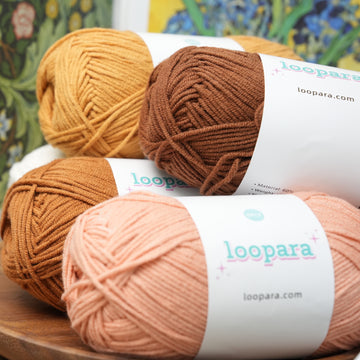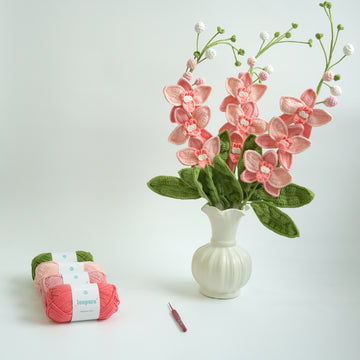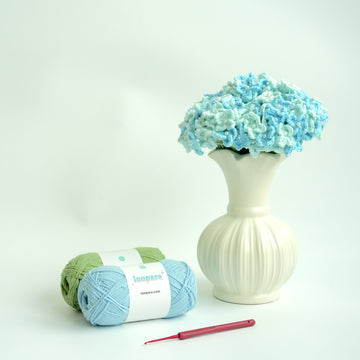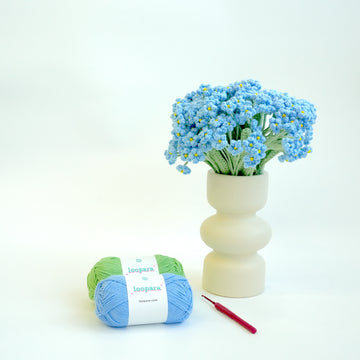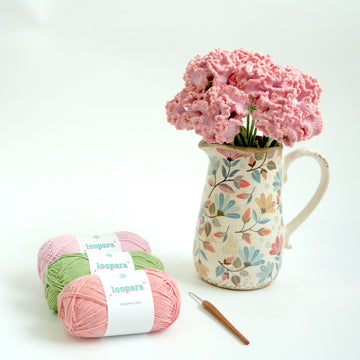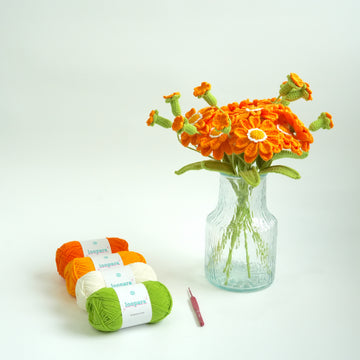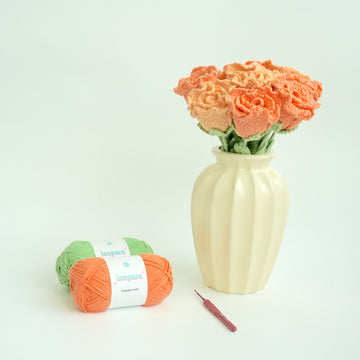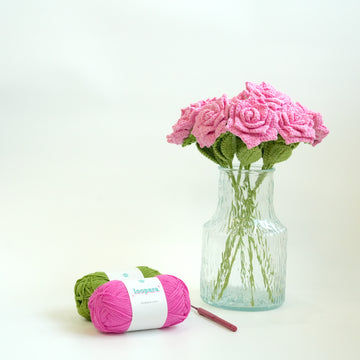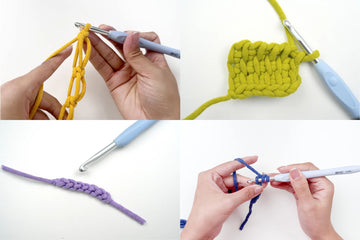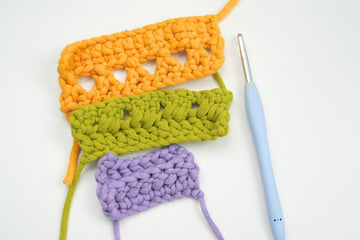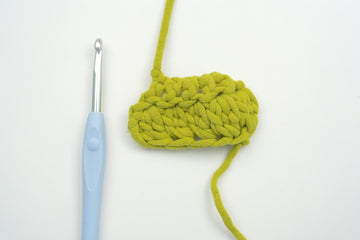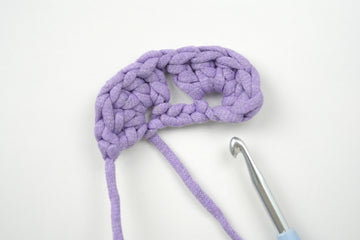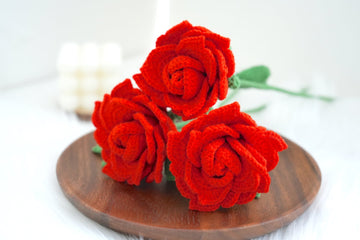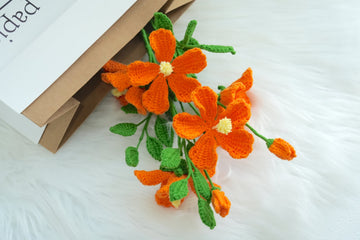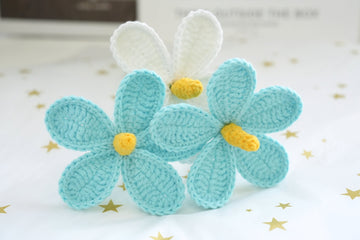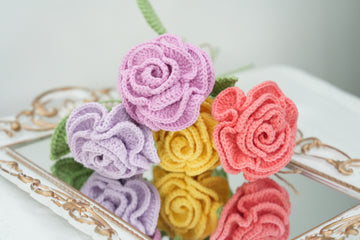There’s a common saying that the US and UK are two countries separated by a common language. And that’s nowhere truer than in the world of crochet!
Anyone learning crochet will soon discover that the two countries use different terminology. And even more confusingly, some of the same terms are used in both countries – to mean different things!
We’re going to look at US vs UK crochet terms. We’ll explain what lies behind the differences. And we’ll provide some handy tables to convert US to UK terminology and vice versa.
Distinguishing between US and UK crochet terms
US and UK terminology differs across a number of different areas of crochet:
- the names of stitches
- the names used for yarn weights
- hook sizes
If you’re following a pattern, the first thing you need to know is if it’s using US or UK terminology. Often, the pattern will set this out clearly. But if it doesn’t, there are lots of ways you can work it out:
- If the pattern refers to single crochet or half double crochet stitches, it’s using US terminology. These terms aren’t used in UK crochet.
- If it refers to “tension”, it’s more likely to be a UK pattern. If it talks about “gauge” instead, it’s more likely to be US.
- If the hook sizes are in numbers or millimeters, it’s a UK pattern (the exception here is the “7” hook, which is part of US terminology). If the hook sizes are designated by letters, it’s a US pattern.
- If the pattern refers to 4-ply, DK or Aran yarn, it’s more likely to be using UK terms. If it talks about fingering, light worsted or worsted, it’s more likely to be a US pattern.
- If you see the abbreviation “yoh” (meaning “yarn over hook”), the pattern is using UK terminology. If the abbreviation is simply “yo” (“yarn over”), it’s using US terms.
- UK patterns will instruct you to “miss” a stitch, while US patterns will use the term “skip” instead.
- Experienced crocheters can also tell what terminology is being used in a pattern by looking at the picture of the finished article. By doing that, they can identify the stitches used and cross-refer to the way they’re described in the pattern.
Why US and UK crochet stitches are called different things
The same stitches are used, whether you’re crocheting in the US or the UK. But they’re called different things – and that can be pretty confusing.
What a US pattern will call a single crochet stitch, a UK pattern will call a double crochet stitch. And to add to the potential for mix-ups, US patterns refer to “double crochet” stitches too. The only problem is, they’re the same as “treble crochet” stitches in UK terminology.
So why the difference?
Well, the US single crochet is called that because it’s made with a single yarn over. Makes a lot of sense, right?
But there’s a good reason for it to be called “double crochet” in UK lingo too. The logic goes that there are two loops on the hook after you’ve pulled up a loop. Double loops for double crochet.
That starting point is what leads to all the different names for stitches.
US vs UK stitch names
Some stitches are called the same thing in both the US and UK systems. Chain stitches and slip stitches are used in both, and the terms mean exactly the same thing.
But in other cases, different stitches are called by the same or similar names. The US double crochet is a different stitch to the UK double crochet. And the US triple crochet is different to the UK treble crochet too.
The table below sets out the terms you’ll see, depending on whether your pattern is using US or UK terminology.
|
US |
UK |
||
|
Stitch name |
Abbreviation |
Stitch name |
Abbreviation |
|
sl st |
Slip stitch |
sl st |
|
|
ch |
Chain |
ch |
|
|
sc |
Double crochet |
dc |
|
|
hdc |
Half treble crochet |
htr |
|
|
dc |
Treble crochet |
tr |
|
|
tr |
Double treble |
dtr |
|
|
FPdc |
Raised treble front |
RtrF |
|
|
BPdc |
Raised treble back |
RtrB |
|
Also Read: 44 Different Types Of Crochet Stitches
US and UK hook sizes
When it comes to hook sizes, there are three main systems – US, UK and metric.
UK patterns used to use the old UK sizing system, also known as “Imperial”. But that started to change in the 1970s, when the metric system was adopted in the UK.
So if you’re using a UK pattern, you may find the hook size is given using either the old UK naming system or metric.
The table below sets out US, UK and metric hook sizes. Not every size in one system matches neatly to an equivalent in another. If there isn’t a perfect match, crocheting a gauge swatch can help you can decide whether to choose the next size up or down.
|
US |
UK |
Metric |
|
B/1 |
14 |
2.00 mm |
|
- |
13 |
2.25 mm |
|
C/2 |
12 |
2.50 mm |
|
- |
11 |
3.00 mm |
|
D/3 |
10 |
3.25 mm |
|
E/4 |
9 |
3.50 mm |
|
G/6 |
8 |
4.00 mm |
|
7 |
7 |
4.50 mm |
|
H/8 |
6 |
5.00 mm |
|
I/9 |
5 |
5.50 mm |
|
J/10 |
4 |
6.00 mm |
|
K/10.5 |
3 |
6.50 mm |
|
- |
2 |
7.00 mm |
|
- |
0 |
8.00 mm |
|
- |
00 |
9.00 mm |
|
- |
000 |
10.00 mm |
US and UK yarn weights
In crochet, yarn weight refers to the thickness of a yarn. Over the years, different manufacturers have used different systems to categorise yarn weight. But these days, most comply with the system set down by the Craft Yarn Council.
That divides yarn weights into eight categories, numbered from 0 to 7. Yarns rated 0 are the thinnest and 7 the thickest. They’re also given descriptive names, and these are the same whether you’re using US or UK systems.
So far, so simple! But alongside the Craft Yarn Council’s names are several others that were used before the Council set out their system. And you’ll still find them used today.
There are no hard and fast rules about which names you’ll see in US patterns and which in UK ones. But it’s fair to say that some are more likely to be used on one side of the pond to the other.
The table below sets out the Craft Yarn Council’s number and naming system, and alongside it the terms more commonly found in US and UK patterns.
|
Weight Category Number |
Craft Yarn Council Description |
US terms |
UK terms |
|
0 |
Lace |
Lace |
2-ply |
|
1 |
Super-fine |
Fingering |
4-ply |
|
2 |
Fine |
Sport |
5-ply |
|
3 |
Light |
Light worsted |
DK, double-knit |
|
4 |
Medium |
Worsted, Afghan |
Aran |
|
5 |
Bulky |
Bulky |
Chunky, rug |
|
6 |
Super-bulky |
Super-bulky |
Super-chunky |
|
7 |
Jumbo |
Roving |
Ultra |
Yarn weights and yarn construction
It’s worth noting that there’s more scope for confusion here! That’s because some of the terms used for yarn weights also have another, different meaning.
Worsted weight vs worsted spun yarn
Worsted weight yarns, as the table above shows, fall into the Craft Yarn Council’s category 3, or “light” yarns. But worsted is also used to describe the way yarns are spun.
There are two main ways yarn can be prepared – worsted and woolen. Worsted yarns are combed before being spun, while woolen yarns are carded first. The spinning techniques differ too.
That gives the two types of yarn different properties. Worsted spun yarns are typically smoother, denser and more lustrous than woolen yarns. Woolens, on the other hand, are lighter, fluffier and more elastic.
Ply in weight vs ply construction
“Ply” is used as part of the UK descriptions of the yarn weight categories 0, 1 and 2 (2-ply, 4-ply and 5-ply). The same terms are used in Australia, where higher yarn weights are also described in terms of the number of plies.
Strictly speaking, though, ply refers to an individual strand making up a yarn. A 2-ply yarn, for example, will have two constituent threads wound around each other. With a 4-ply yarn, there are four individual threads.
It’s easy to see how plies came to be associated with yarn thickness. As long as each constituent strand is the same thickness, a 4-ply yarn will be thicker than a 2-ply. In reality, of course, those individual strands can vary in thickness too.
If you see a skein of yarn labeled 4-ply, make sure you check if it’s referring to the yarn weight or its construction. If it’s not clear, work up a gauge swatch to check the weight will be suitable for your project.
Summary: US vs UK crochet terms
US and UK crochet terminology can give rise to confusion. Different terms – or the same term meaning different things – are used for stitches, hook sizes, and yarn weights. Other pattern instructions vary too.
But once you’ve identified which system a pattern is using, you’ll be able to follow it with ease. Patterns will usually tell you that. But if they don’t, there are lots of different ways you can tell.
A dead giveaway for US terminology is the appearance of “single crochet” or “sc”. And a crochet hook size in numbers or millimeters almost always means you have a UK pattern.
Enjoy becoming bilingual in crochet!


